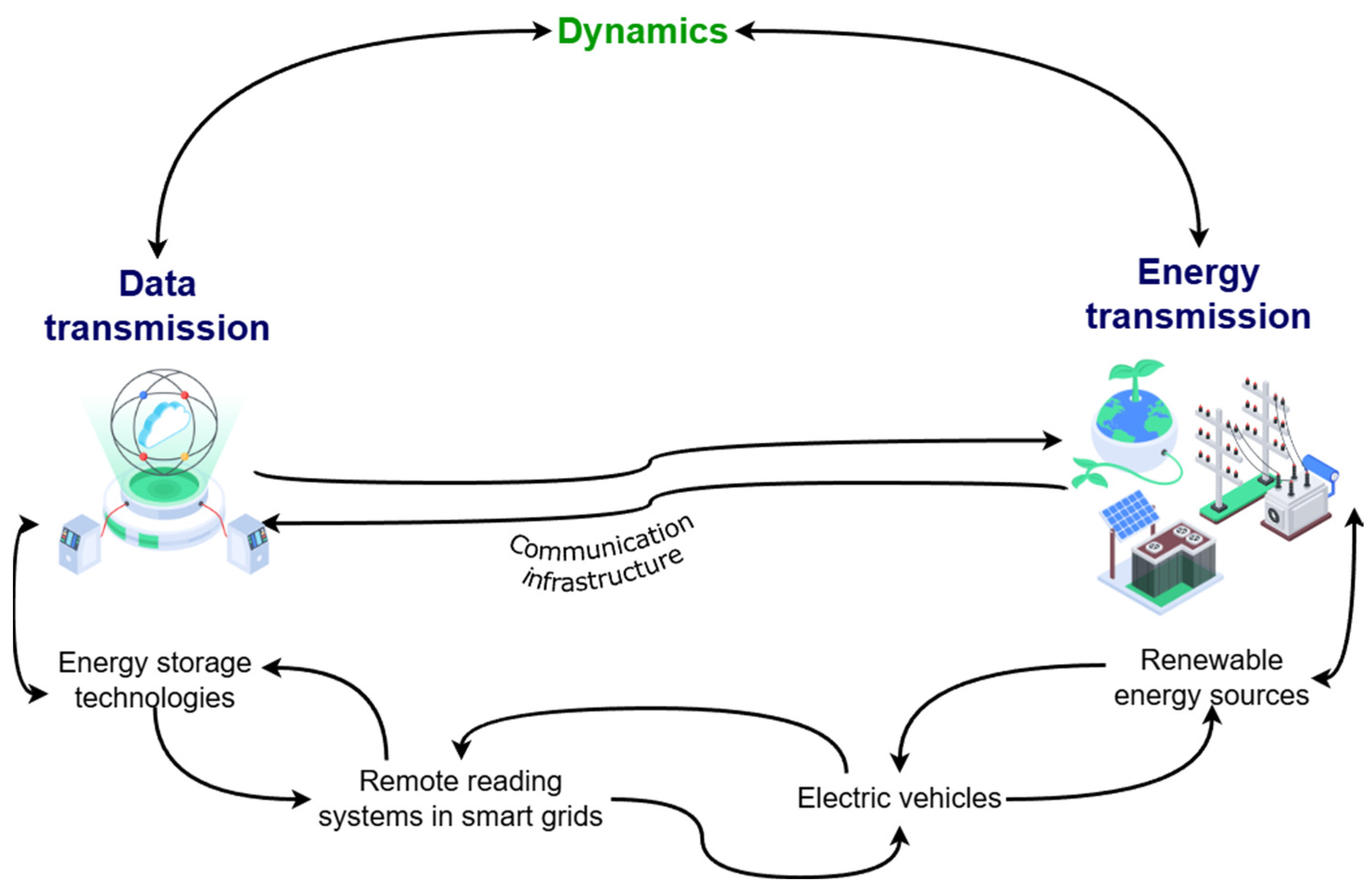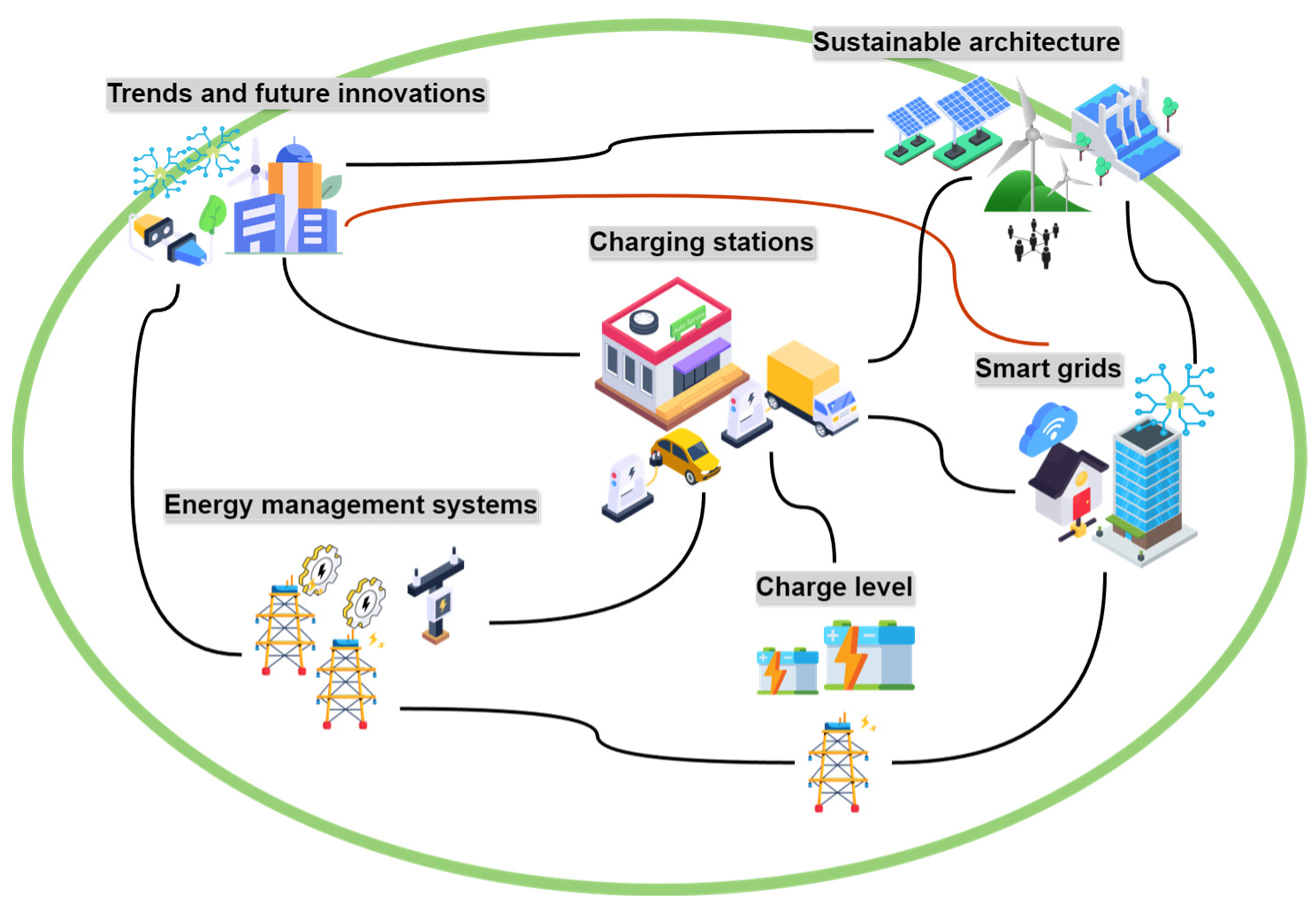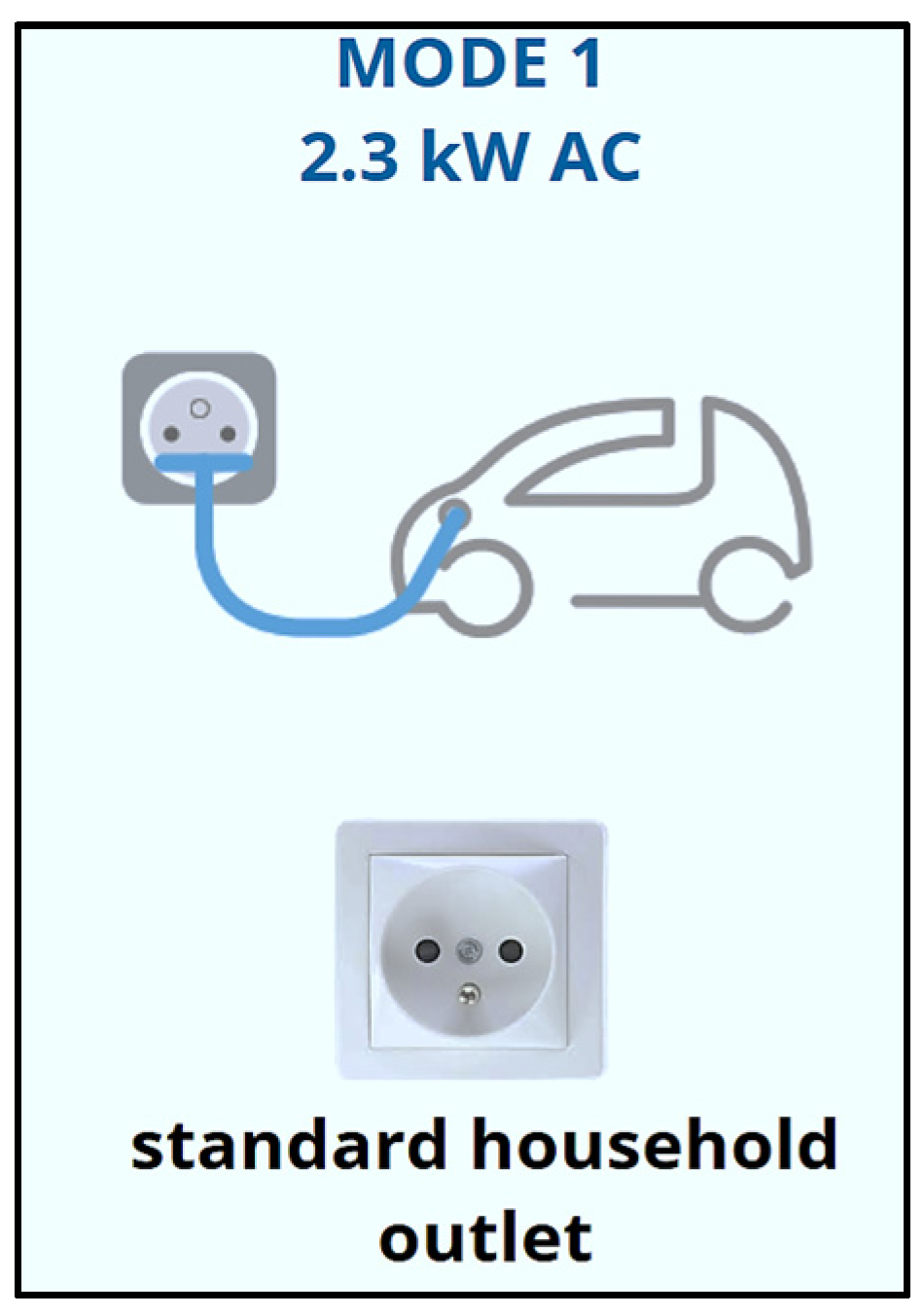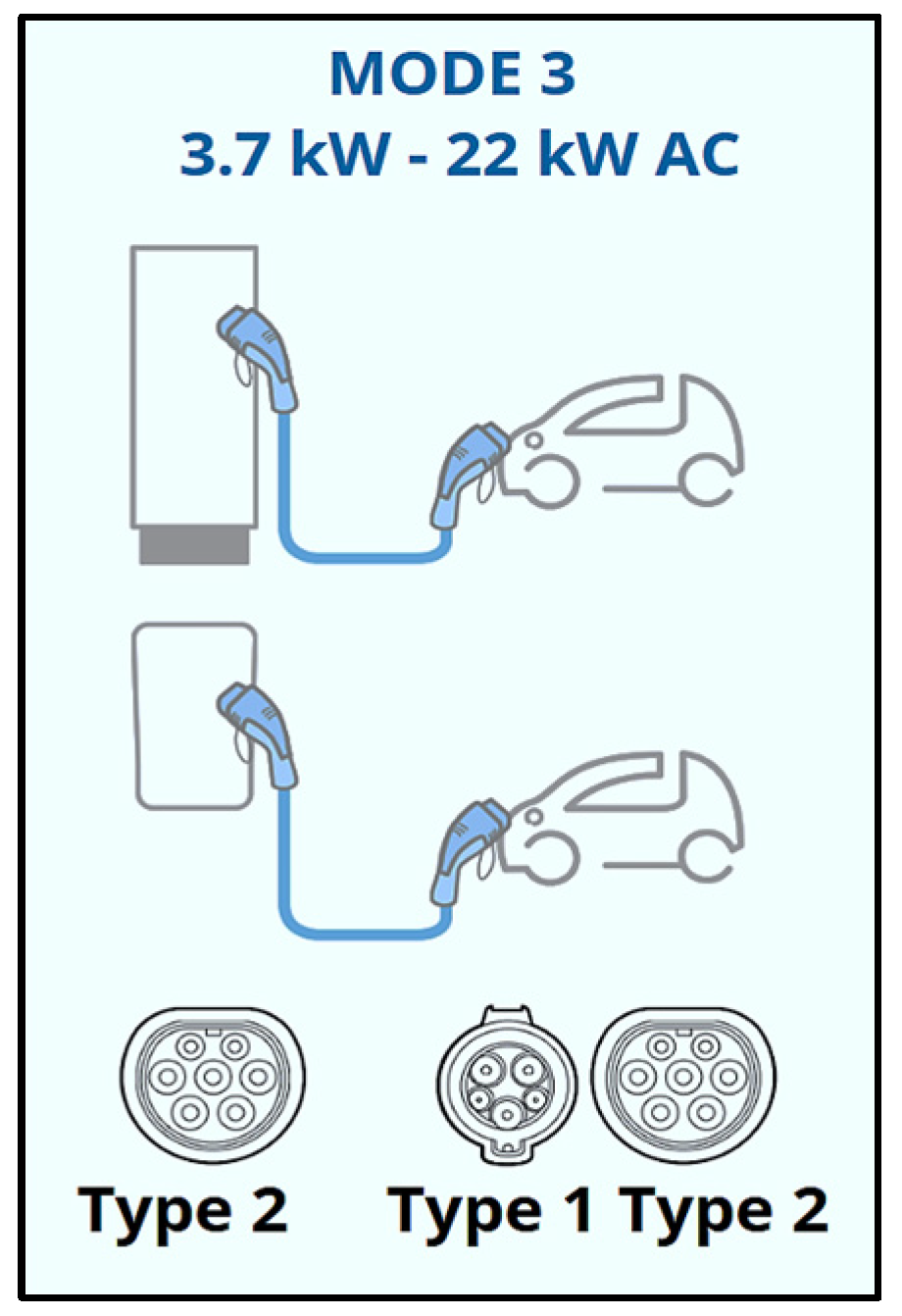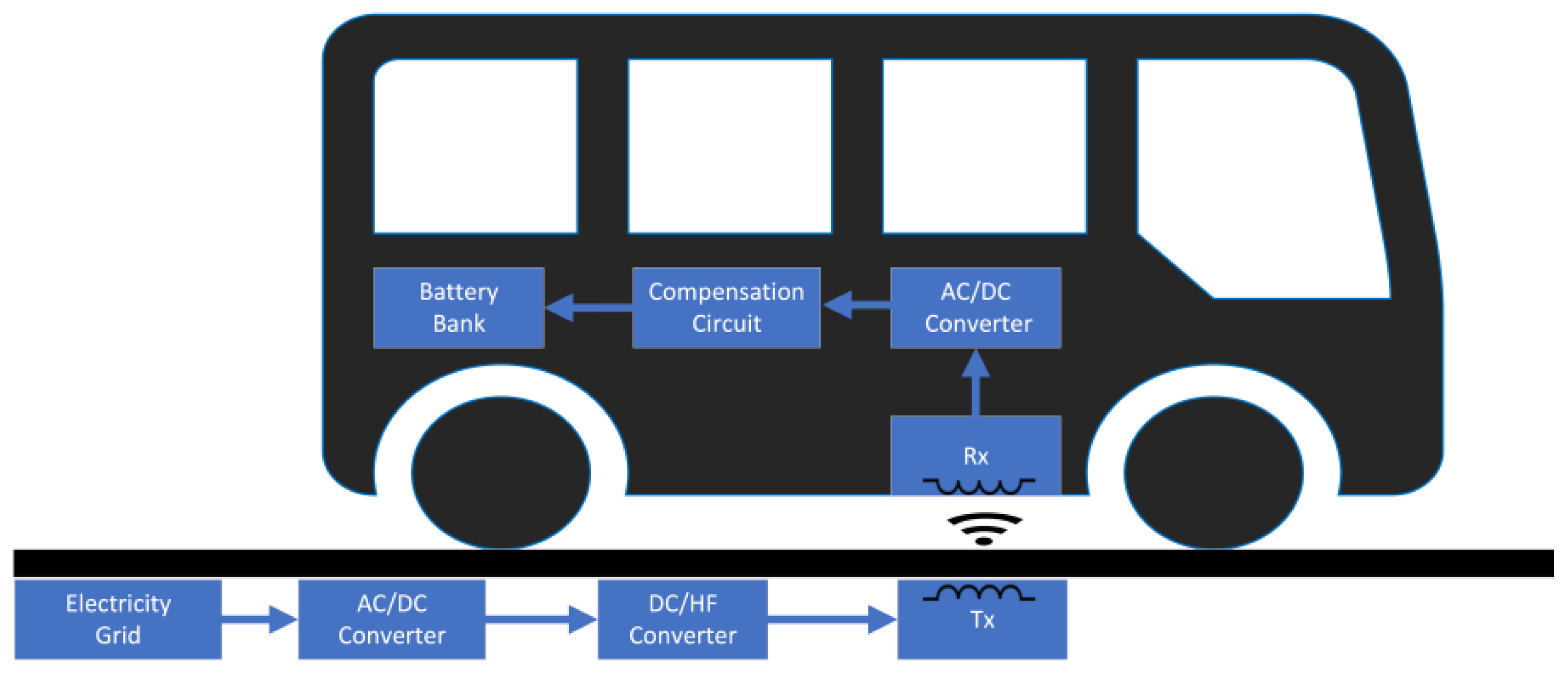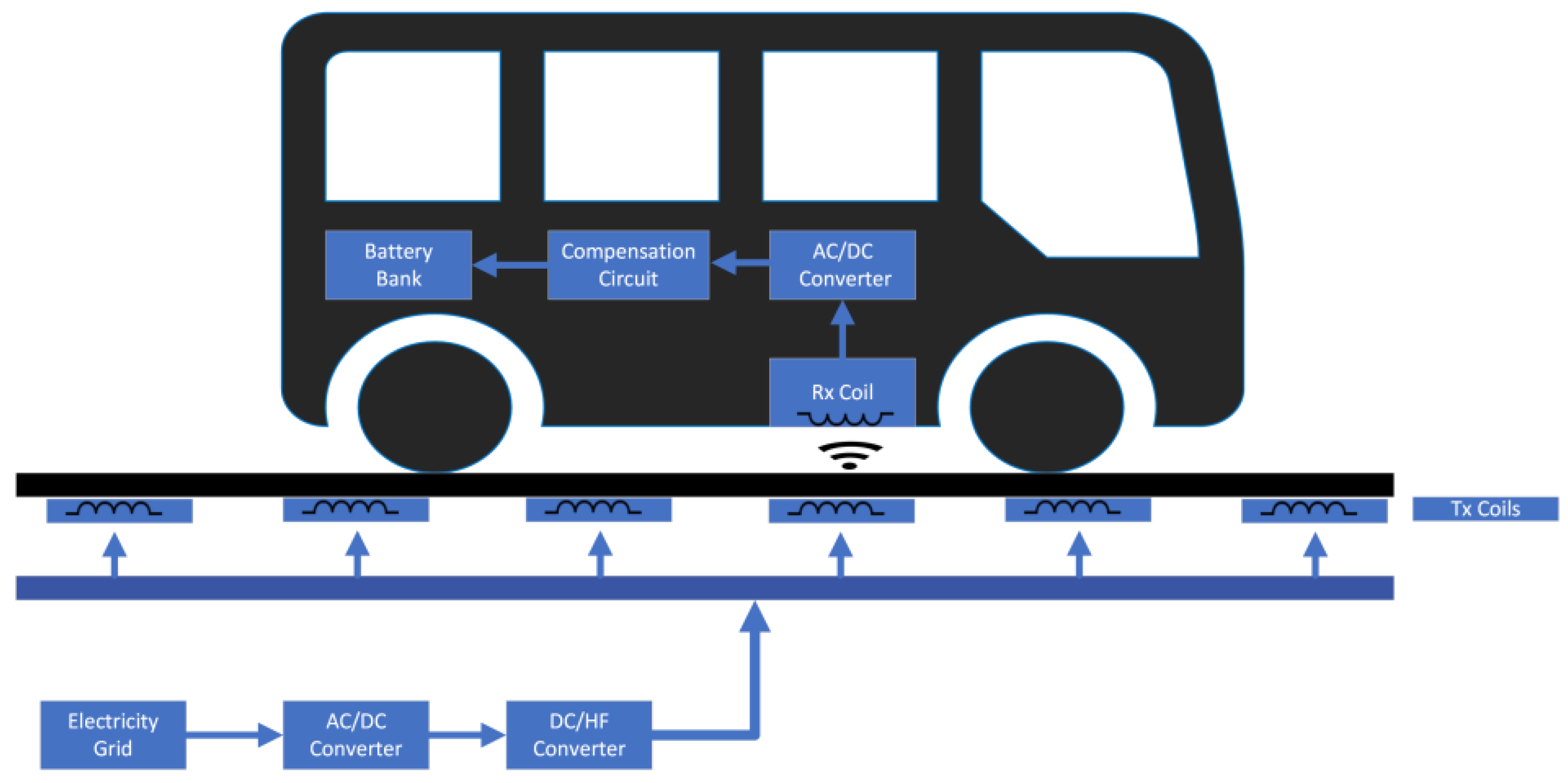1. Introduction
The growing energy crisis and environmental degradation have prompted governments and institutions to accelerate the search for cleaner fuels to reduce vehicular traffic emissions. In this context, electric mobility is emerging as a key solution, particularly in urban settings, where the adoption of renewable technologies in automobiles seeks to gradually replace internal combustion vehicles [
1].
In recent years, the proper planning of the location of charging stations (CS) and the management of energy demand in a region have gained importance in society. This strategy is essential for the transition towards sustainable energy, representing a crucial step in promoting cleaner and more efficient mobility [
2].
One of the main challenges in the widespread adoption of electric vehicles (EVs) is the development of an adequate and accessible charging station network that not only supports the growing number of vehicles, but also integrates renewable energy sources and efficiently manages energy demand. In this regard, CS should be viewed as a key node within the energy system, interacting bidirectionally with smart grids (SGs) and contributing to the optimisation of energy supply.
The systemic approach is crucial for understanding how charging stations can function not merely as energy supply points, but as integral components of an energy ecosystem that balances electricity generation, storage, and distribution. This approach allows for the consideration of the interaction between charging stations, EV users, power grids, and renewable energy sources, ensuring a more flexible and sustainable energy transition.
This review examines current and emerging technologies related to EV charging stations, from the integration of renewable sources such as solar, wind, and tidal energy to the implementation of advanced energy management technologies and ultra-fast charging solutions. Additionally, it addresses the regulatory and policy barriers that hinder interoperability between charging stations and vehicles from different manufacturers, highlighting the need for greater global standardisation.
The importance of an efficient charging infrastructure extends beyond facilitating EVs’ adoption; it also plays a critical role in the decarbonisation of the energy sector. The integration of renewable energy into charging stations, along with the use of technologies such as energy management systems and SGs, enables greater grid flexibility, reduces reliance on fossil fuels, and improves the stability of electricity supplies.
This article delivers a comprehensive analysis of electric charging stations, emphasising emerging technologies, the integration of renewable energy, and future trends. Each section explores key components, including smart grids, charging levels, and sustainable architectures, within a systemic framework aimed at advancing sustainability in electromobility.
2. Taxonomy
The growing demand for a sustainable energy supply has created the need to develop smarter grids that utilise advanced technologies and innovative tools to operate viably and efficiently. These grids must be capable of maintaining affordable maintenance costs, integrating a greater proportion of renewable energy sources, and reducing users’ carbon footprints, among other benefits [
3].
SGs are considered a key tool in achieving a wide range of strategic and environmental goals in the energy sector. However, their implementation varies globally, and roles within these networks are still not clearly defined or assigned. Unlike traditional systems, SGs operate in a more horizontal manner, allowing for greater flexibility in energy management and distribution, thus enabling more efficient integration of new technologies and renewable energy sources [
4,
5].
SGs are characterised by the integration of innovative technologies in communication, control, monitoring, and self-diagnosis, forming an ever-evolving platform that incorporates smart meters, internet connectivity, and energy regulation, all driven by incentives and advanced technologies [
6].
SGs are structured into three fundamental layers: an energy flow layer, a communication layer, and a computing layer based on information technology. These layers work together to balance energy consumption and demand, optimising the overall efficiency of the system. Thanks to their bidirectional functionality, users can not only consume electricity, but also sell surplus energy to utility companies. To facilitate this process, a bidirectional communication system monitors and regulates the energy flow between the user and the grid, enabling both producers and consumers to manage energy exchanges in real time. Additionally, this technology allows energy providers to remotely control supply via internet-connected platforms, enhancing the system’s flexibility and responsiveness [
7].
In the context of SGs, the infrastructure consists of various layers and systems that enable the efficient and balanced management of energy resources. These grids are equipped with two distinct transmission lines: one dedicated to the flow of energy and another to the flow of data, facilitating bidirectional communication between the different entities within the network. This exchange of information allows for the continuous optimisation of energy systems [
8].
Figure 1 illustrates the infrastructure of SGs from a systemic perspective, encompassing the components of energy flow, communication, and computation, which interconnect to optimise energy balance. Additionally, the system integrates renewable energy sources as a core element.
The incorporation of advanced technologies such as energy storage, renewable energy sources, EVs, and remote reading systems into SGs adds a significant level of complexity to the communication infrastructure. Each of these technologies requires precise coordination and efficient data flow management, which necessitates greater processing capacity and a more robust infrastructure [
9].
Moreover, the integration of these technologies introduces new demands in terms of security technology, interoperability, and real-time responsiveness, thereby increasing the technical and operational challenges within the grid. This complexity not only affects data transmission, but also the grid’s ability to adapt and evolve as new technologies and user and operator needs emerge.
Figure 2 illustrates the main elements influencing the composition of the electric charging station system (ECSS). These components include charging stations, energy management systems, sustainable architecture, SGs, and charging levels. Additionally, the importance of trends and future innovations is highlighted, as they play a key role in the evolution and optimisation of these charging systems.
Figure 2 highlights the key components of the ECSS, including charging stations, energy management systems, and charging levels. Furthermore, it emphasises how future trends, such as automation and technological innovations, drive the optimisation and sustainability of these systems.
Thus, the taxonomy of SGs reflects their capacity to efficiently integrate advanced technologies and manage both energy and data flows. By operating bidirectionally, these networks not only optimise the balance between energy demand and supply, but also facilitate the incorporation of new renewable sources and emerging technologies. This systemic approach provides the conceptualization of a more flexible and sustainable energy infrastructure, one that is better prepared to meet future challenges in energy management.
3. Types of Charging Station
An adequate infrastructure that allows users to recharge their EVs would facilitate their adoption [
10]. The use of fast, reliable, and convenient technology would simplify the integration of EVs by consumers. The adoption of these vehicles promotes more sustainable transportation and reduces dependence on fossil fuels. However, conventional power plants and other generation sources may also increase their emissions. The rise in energy demand must be met through a massive deployment of renewable sources, whose integration must be coordinated with the rise in EV numbers [
11,
12].
One of the most common ways to classify electric charging systems and their infrastructure is according to the type of connection, whether inside (on-board) or outside (off-board) the vehicle. On-board chargers are always active during the charging process, as they manage the voltage and current supplied, which helps to extend battery life and reduce charging times [
13]. Generally, this type of charger has a low level of active power and can be connected directly to a low-voltage residential socket, although it is also possible to connect it to an off-board charger. On the other hand, off-board chargers are more powerful, enable faster charging times, and are typically located in strategic locations such as homes, businesses, offices, and highways [
14].
Finally, as electric vehicle charging technologies and system designs advance, efforts are being made to standardise technologies and devices through manufacturing and service standardisations to ensure that connection systems are as compatible as possible. The creativity of the designers and engineers involved in the design of charging stations should not be limited by the standards, regulations, or policies of each city.
Design technology standards and regulations are developed by various institutions and vary depending on the environment and country. The International Electrotechnical Commission (IEC) regulates charger technologies in Europe; in the People’s Republic of China, they are regulated by Guobiao (GB/T); in North America and much of the Americas, the Society of Automotive Engineers (SAE) and the Institute of Electrical and Electronics Engineers (IEEE) set the standards; and in Japan, standards are primarily developed through CHAdeMO, although SAE standards are also employed.
As detailed in
Table 1, the charging levels defined by the IEC are essential for ensuring the interoperability of residential and commercial charging systems.
The most significant design difference between these two types of standards lies in the types of ports and connectors used. Additionally, it is essential to consider the voltage levels that each country operates on within its main electrical grid, which must not be overlooked during the design process.
3.1. Residential Charging
Residential EV charging stations are systems installed in homes to efficiently recharge EV batteries. These compact systems allow homeowners to charge their vehicles overnight or when not in use, utilising the home’s electrical grid.
Residential charging systems are the simplest, supplying electricity to the EV through low voltage levels. In some cases, they have their own independent metering system separate from the household grid, while in other instances, the billing is shared with the home. In private stations, such as those located in offices, vehicle charging is regulated by adjusting the power output based on the battery’s charge level, helping to maintain grid stability. Lastly, public charging stations typically feature Level 2 chargers and fast chargers, so their placement must be carefully selected, as an inappropriate location can negatively impact both the grid and users.
As is well known, residential sector electricity tariffs are not fixed, but increase for the user based on consumption brackets in kWh. This characteristic makes it difficult to calculate the cost of charging an electric vehicle for a residential customer.
3.2. Public Charging
Public charging stations for EVs are structures installed in publicly accessible locations such as shopping centres, service stations, parking lots, and highways. These stations are designed to provide energy to electric vehicles quickly and conveniently. There are three main types of public charging stations, each with different power levels and charging speeds. Public charging stations have unique features that distinguish them from other types of infrastructure, such as the following:
Interoperability: many stations are compatible with a variety of electric vehicle brands and models, though they are primarily designed for specific vehicles from certain brands or companies.
Strategic locations: these stations are placed in key points such as highway service stations, hotels, shopping centres, airports, and densely populated urban areas, making them easily accessible to drivers.
4. Charging Levels
4.1. Level 1 (Slow Charging)
This refers to stations that provide electric energy for the slow charging of EV batteries. While it is common knowledge that a petrol station supplies fossil fuel, an electric charging station (ECS) serves the same purpose but provides electricity instead of gasoline (
Figure 3). There are various types of charging system that depend on the standards used in each country [
17].
According to IEC 61851, the conductive charging modes for EVs are as follows: mode 1 charging—AC: a grid connection with a maximum of 16 Amperes per phase (3.7–11 kW).
4.2. Level 2 (Moderate Charging)
This involves a connection to the electrical grid using a special cable, which includes an intermediate electronic device with a control pilot function and direct current residual (DCR) protection (
Figure 4). The maximum is 32 Amperes per phase (7.4–22 kW).
4.3. Direct Current Fast Charging (DC Fast Charging)
This type of charging station is exclusively for use by the vehicle and is permanently connected to an alternating current (AC) supply. It uses a connector that is incompatible with the standard electrical grid connector (5 or 7 pins for EVs). The maximum is 64 Amperes per phase (14.8–43 kW) [
15].
Figure 5 illustrates the schematic of the DC fast charging mode, which provides significantly shorter charging times compared to traditional modes.
Currently, as previously mentioned, recent studies have explored new ways of supplying and charging for energy at ECSs. According to one of the pioneering contributions in this field of research, which focuses on the design of new techniques and energy management methods, it has been proposed that the connection points for ECSs should be distributed throughout the city, based on the topological layout and network parameters of the distribution grid [
17]. Subsequently, the energy flow within the distribution grid and its capacity to handle the increased demand can be calculated. Finally, the feasibility of interconnecting ECSs is assessed, including determining the number of individual charging stations that can be accommodated. Once the contributions of both authors are explained, they reach a similar conclusion. Zhang [
18] presents a diagram that outlines, in general terms, how energy management and supply should be handled in cities, proposing a design where all charging stations are interconnected at a central node. Each zone or part of the city is represented geographically by dotted boxes, and each charging point is an ECS.
In a schematic format, as a summary of the main characteristics of the voltage and power levels for energy charging.
Figure 4 illustrates how different types of vehicles, with these general characteristics, correspond to each previously discussed level/mode.
The direct current (DC) fast charger can replace Level 1 and Level 2 chargers. Depending on the manufacturer, its output power ranges from 50 kW to 500 kW. In addition to having a higher power capacity, the energy conversion and control become more expensive and bulkier. DC fast chargers are generally installed off-board (outside the vehicle) to avoid interference with power lines. Another reason is safety, as the size of power converters and energy management components increases, making passenger safety a key concern [
19]. Currently, DC connectors come in five main variants, which are detailed below.
On the other hand, the types of levels and connections for charging stations can also be represented, including newer or more specific energy transfer configurations and technologies used in some of the most popular car models on the market [
20], as shown in
Figure 6, where the general infrastructure of electric vehicle chargers is depicted, highlighting the integration of innovative technologies such as inductive charging.
Figure 7 categorises the types of chargers, including advanced configurations such as battery swapping modules. This diagram includes conductive charging types, inductive charging, and battery swapping modules.
5. Energy Management Systems
Electric vehicle charging stations must be viewed using a systemic approach, as they act as intermediaries between electric vehicle users and the main power grid. In general, the charging station must have the capacity to supply electrical power to a large fleet of electric vehicles and help maintain a proper and balanced energy dispatch to the grid, as well as manage local charging to optimise and reduce total operational costs [
21]. Balancing minimal costs with power among several components simultaneously under a dynamic load remains a challenge.
Through systemic thinking, charging stations should not only meet technical specifications, but also fulfil the objectives of investors and users. These objectives range from basic management to more advanced energy management and control, and are outlined as follows:
Control of Electrical Parameters: the voltage and current of the converters must be adjusted to their reference values, ensuring that oscillations are properly controlled.
Energy Management: electrical parameters, such as the voltage and charging current required by electric vehicle batteries, must be maintained while minimising negative impacts on the grid—for example, by limiting peak power and reducing harmonic distortion.
Electrical System Stability: system values must be monitored and balanced, including maintaining a stable frequency in alternating current and the appropriate voltage in the AC/DC bus, under varying load conditions.
Economic Dispatch: the electrical power required for users’ charging demand must be supplied within a limited time, reducing costs without compromising user satisfaction.
5.1. Smart Grids
The incorporation of EVs into the smart grid can be leveraged by utility companies and other industry players to generate various benefits and improve grid performance. The relevance of the vehicle-to-grid (V2G) concept was highlighted as an example of services that will facilitate the transition from a static energy system to a more efficient virtual grid. The installation of networks of ECSs can help stabilise the grid and offer benefits in areas with excess energy; electric vehicles can absorb surplus solar generation during the day and mitigate wind energy curtailment at night [
22].
EVs can play a dual role, acting as an alternative energy storage option for the grid that is also available to the public. This would allow vehicle owners to be compensated for supplying energy when their cars are not in use, helping to reduce maintenance costs. Additionally, it could improve quality of life in large cities by shifting emissions away from densely populated areas. This shift in energy production would improve air quality and public health in urban areas, while emissions would decrease further by meeting energy demand with renewable sources.
However, it is crucial to consider that integrating a large number of EVs into the power system poses a significant challenge, requiring in-depth evaluation of the economic impacts, operational benefits, and control under ideal circumstances. The mass integration of EVs into the smart grid can generate several problems if not managed carefully. According to various studies evaluating the impact of EVs on the power distribution system, adverse effects such as transformer overheating and the need for new investments in distribution infrastructure are anticipated [
23].
The systemic approach emphasises the relevant systems that facilitate communication and energy management of stations in smart cities. These systems must incorporate the concept of the smart grid into their energy infrastructure, paving the way for future network planning [
24]. The infrastructure for smart metering elements enables bidirectional communication at all interconnection points within the smart electrical grid. This is supported by communication and control systems designed for the stations [
25]. Through IoT technologies, users can perform real-time actions that directly influence the grid.
5.2. V2G Energy Management
The term plug-in electric vehicle (PEV) includes both pure electric vehicles and plug-in hybrids, referring to those with rechargeable batteries that can be fully recharged by connecting to an electricity source. However, PEVs are complex systems that integrate multiple mechanical, electrical, mechatronic, and electronic components. Their performance can be influenced by various factors such as road conditions, environment, and driving style. For this reason, advanced control systems are used to properly manage their internal components. Each time a vehicle is connected to a charging station in a parking lot, it is important to record battery parameters such as the initial state of charge (SOC), the available capacity, and other user-specific data to ensure efficient energy management.
The electrical grid transports electricity from generation points to end users. Due to the characteristics of energy generation, particularly its inefficiency in managing demand peaks, as well as transmission and distribution challenges, specialists have noted that local distribution could be a vulnerable link in the chain when faced with the unregulated charging of PEVs [
26]. These issues can be addressed with the use of a smart grid, which focuses on both electrical and information infrastructure, encompassing three key areas: (i) demand management, (ii) distributed electricity generation, and (iii) monitoring and control.
Monitoring and control of the grid are essential to ensure that electricity production matches demand. If supply and demand are not balanced, generation plants and transmission equipment can fail, potentially leading to significant regional blackouts. The transmission system is designed to handle base loads and peaks, with safety margins and fault tolerance. Control and dispatch centres are responsible for managing and controlling the interconnected electrical grids.
An infrastructure with the flexibility provided by vehicle–grid integration (VGI) systems is complex and involves charging stations, communication protocols, security measures, and a connected grid that includes both conventional generation and renewable energy sources (RES), along with control algorithms. The implementation of VGI can vary throughout the day (
Figure 8). From an economic perspective, the auxiliary services offered through VGI, such as frequency and/or voltage regulation, peak shaving, load balancing, congestion mitigation, spinning reserves, and reducing intermittency and curtailment, may prove more valuable than simple energy storage. However, its implementation is also more complex.
6. Sustainable Architecture
One of the main obstacles preventing the mass implementation of electromobility technologies is the limited charging infrastructure for EVs. Currently, the number of charging points, especially fast-charging stations, is insufficient to meet the growing demand, which significantly hampers the expansion of these vehicles. This lack of infrastructure discourages potential users, who see the absence of charging stations as a barrier to transitioning to cleaner technologies. Therefore, it is essential to expand and improve the charging station network, integrating new architectures as part of strategies to promote the widespread adoption of EVs and support the development of electromobility.
6.1. Renewable Energy and Storage
The incorporation of renewable energy in EV charging is an emerging trend with the potential to transform both the transportation and energy sectors. As the world strives to reduce carbon emissions and address climate change, as evidenced by the increase in EV sales in 2024 across various European countries, integrating renewable energy sources into EVs’ charging infrastructure has become a critical step towards sustainability. Some stations are already incorporating solar panels and battery systems to offer a renewable energy source.
Renewable energies, such as solar, wind, and hydropower (
Table 2), are gaining increasing importance in the mix of energies used for electric vehicle recharging. This integration supports cleaner transportation and helps align with global sustainability goals.
One of the limitations of renewable energy sources is that, to avoid energy loss, the generated energy must either be used immediately or supplied to the electrical grid, as shown in
Figure 9. Therefore, researchers have suggested adopting stationary energy storage systems and fast-charging systems to address this issue [
27]. Energy storage mitigates the disruptions caused by renewable energy intermittency and enhances the stability of electric vehicle charging by supplying adequate power during emergencies.
6.2. Payment and Authentication Systems
The inability to accept and process payments is a common cause of failures in public EV charging sessions. While no specific data are available to classify the severity of payment issues, information from members of the National Charge Experience Consortium (ChargeX Consortium) suggests that payment problems continue to present challenges. Additionally, the data indicate that credit card readers have been more prone to failure compared to other payment methods. The variety of payment options commonly offered to customers at public EV charging stations increases the complexity of resolving these issues.
This paper considers the following payment methods: credit card readers, radio frequency identification (RFID), near-field communication (NFC), apps, Plug & Charge, and methods such as phone calls, text messages, and Short Message Service (SMS).
There are multiple methods available for paying for an EV charging session. This flexibility allows customers to choose from various options to meet different user needs and provides alternatives if a preferred method fails. Most payment methods rely on a network connection to authenticate the payment and allow the charging session to begin. All payment methods can be affected when a customer has an invalid credit or debit card, or outdated payment information stored in an account. The hardware for credit card readers, NFC, and RFID is susceptible to durability issues, environmental conditions, and vandalism. The authors are not aware of any EV charging station that accepts cash payments [
28].
On the other hand, more sophisticated payment methods also exist, such as NFC, a subset of RFID. NFC is a wireless communication method that enables contactless payment through credit or debit cards, smartphone apps (e.g., Apple Pay, Google Wallet, Samsung Pay), wearables, and other contactless payment cards. Credit card readers are typically NFC-enabled, or there may be a separate NFC device in the electric vehicle supply equipment (EVSE). Payment issues with NFC generally arise due to the customer’s account having an invalid or expired credit or debit card, or due to network connection problems.
7. Trends and Future Innovations
In the realm of SGs, future trends and innovations are focused on enhancing the efficiency and sustainability of energy systems through the adoption of advanced technologies and new architectures. These innovations include advances such as the integration of wireless charging technologies, automation through robotic charging systems, and the development of hypercharger networks, all aimed at improving storage capacity and energy supply efficiency, enabling real-time optimisation of supplies, and developing infrastructure that facilitates the widespread adoption of renewable energy sources.
Additionally, advancements in electric vehicle charging infrastructure and decentralised energy management systems are expected to play a crucial role in the evolution of electromobility, overcoming the current barriers and accelerating the transition to cleaner and more sustainable technologies.
7.1. Wireless Charging
The wireless transmission of energy to supply power to electrical devices is a technology still in search of greater efficiency. EV charging is one of the many areas where wireless energy transfer (wireless charging) shows significant potential and is being actively researched for its applications.
The current commercial car charging systems, which operate via cable or plug, are known as conductive charging systems. These systems present several drawbacks. For example, they require heavy cables and connectors, and the charger must be manually connected to both the power source and the device being charged. This type of charging is not particularly user-friendly or environmentally friendly. In the event of a short circuit or cable insulation failure due to factors like high temperatures, friction with the ground, or the charging device itself, an electric shock could occur, potentially resulting in fatal consequences [
29].
To reduce charging time and, consequently, the associated risks, a large number of batteries can be employed, or discharged batteries can be swapped for charged ones when necessary. For example, if a vehicle can travel a certain distance on a single charge and a specific number of batteries, its range can be extended by using additional batteries. Alternatively, the vehicle’s batteries can be swapped at charging stations during the journey. However, batteries also present their own set of challenges.
As previously mentioned, wireless charging systems for EVs are classified according to the required charging mode, that is, whether charging occurs when the vehicle is stationary or in motion. Within this classification scheme, two main types of charging are typically discussed: static charging (
Figure 10) and dynamic charging (
Figure 11). In terms of these two types, the key differences are as follows:
Static: occurs when the vehicle is stationary, typically in parking spots or designated charging areas that are designed for vehicles to charge in while parked.
Dynamic: takes place while the vehicle is in motion, enabling continuous energy transfer as the vehicle moves along a road equipped with wireless charging infrastructure.
7.2. Automatic and Robotic Charging
In order to achieve more powerful DC charging, it is necessary to increase the cable diameter. However, this makes the cable heavy, rigid, and difficult to handle, which can complicate the process of charging vehicles for individuals. This need for more accessible vehicle charging is one of the reasons why automated conductive charging systems are gaining increasing interest.
Autonomous vehicles, combined with automated charging systems, present new opportunities. Fully automated parking and charging solutions enable innovative, customer-focused service concepts. For example, a driver could park in front of a shopping centre, the car would then autonomously drive to the nearest available parking space, automatically charge its batteries, and pick up the driver after their shopping via a call from a mobile app. Companies like Tesla, BMW, and Volkswagen are developing similar projects with automated robotic systems [
30].
Recent research has demonstrated that deep learning has significantly improved the accuracy and efficiency of automated charging systems and robotic systems for automatic charging. Emphasising the growth of technology and automation elements, a systemic approach allows for better identification of methodologies for battery swapping using automatic robotic systems at charging stations, thereby addressing some current issues in automatic systems. The innovation infrastructure for robotic systems at charging stations can also be classified based on innovations in the types of mechanisms used [
31].
Although they are still in the preliminary engineering phase, the goal of examining these future trends using a systemic approach is to find methodologies for charging electric cars through automated systems that eliminate the need for human intervention entirely.
On the other hand, it is important to consider the design of charging stations with automated systems, incorporating a management system that addresses aspects such as battery availability, charging stations, and communication systems. Effective communication between the different elements and stakeholders is essential to ensure interconnection. The success of the battery swapping system will depend on continuous communication between the vehicle and the robot. Communication plays a crucial role in facilitating interaction with both the vehicle and the station [
32].
Specialized literature divides charging technologies for heavy-duty electric vehicles into two main categories: static charging and dynamic charging. Both types of technology provide unique solutions to the challenges associated with the electrification of heavy-duty vehicles. Thes challenges include reducing downtime and improving range during long journeys [
33]. Additionally, these solutions could be effectively applied to charging stations for smaller electric vehicles.
Figure 12 illustrates an automated robotic battery charging system developed by Hyundai can be observed.
7.3. Ultra-Fast Charging Networks (Hyperchargers)
Also known as ultra-fast chargers (UFC), this type of charging station system allows electric vehicle batteries to charge at a significantly faster rate than conventional chargers. These chargers can deliver charging power ranging from 150 kW to over 350 kW, enabling the battery of an electric vehicle to be charged in a considerably shorter time, often in less than 30 min, depending on the battery’s capacity and state of charge [
34].
It is essential to have a common charging standard to ensure the interoperability of UFC station infrastructure. This ensures that different vehicle models and charging equipment are compatible. The widespread adoption of such a standard allows EV owners to charge at any UFC station, regardless of who operates the charging network, promoting seamless interoperability.
In addition to charging standards, standardised communication protocols, such as the Open Charge Point Protocol (OCPP), also facilitate interoperability by enabling communication between charging stations, backend systems, and energy management platforms. These protocols ensure compatibility, data exchange, and remote control functionalities, allowing for efficient operation, monitoring, and management of UFC infrastructure.
It is important to note that EV charging protocols and the UFC system use communication protocols to ensure efficient and seamless charging operations. Some of the most important communication protocols used in UFCs for EVs include CCS, OCPP, IEC 61850 [
35], and OpenADR. CCS is based on the ISO 15118 [
36] and DIN 70121 standards [
37], enabling bidirectional communication between the EV and the charging infrastructure.
Roaming agreements allow EV owners to access charging services across different networks using a single payment method or subscription. The implementation of these agreements encourages wider adoption of the UFC infrastructure, enhances customer convenience, and reduces the need to maintain multiple accounts across different charging networks. This new generation of chargers can deliver power exceeding 500 kW, reducing charging time to less than 10 min [
38].
8. Conclusions
This comprehensive review of ECSs for EVs uses a systemic approach to highlight the growing importance of charging infrastructure in the transition to sustainable mobility. It emphasises the relevance of adopting emerging technologies that optimise both energy efficiency and responsiveness to the increasing demands on the electrical system. The reviewed literature concurs that integrating advanced technologies—such as wireless charging, automatic and robotic charging, and hypercharger networks—will not only enhance charging speed and efficiency, but also play a crucial role in overcoming the current barriers preventing the widespread adoption of EVs.
One of the key points is the urgent need to expand charging infrastructure, both in terms of quantity and geographical coverage. Various authors agree that the lack of fast and accessible charging stations remains one of the main obstacles to the expansion of electromobility. This scarcity of infrastructure hampers the adoption of EVs, which in turn negatively impacts global efforts to reduce fossil fuel dependence and carbon emissions. Therefore, the urgent need for national policies and strategies that promote the development of more extensive and efficient charging networks is highlighted.
The reviewed literature also underscores the importance of SGs as an essential component for the effective integration of this infrastructure. With their bidirectional capabilities, SGs enable efficient management of the energy flow between the grid and users, facilitating not only the charging of vehicles, but also the sale of surplus electricity by users, thus enhancing the flexibility of the energy system. It is crucial to note that the implementation of SGs, in combination with renewable energy types such as solar, tidal, hydroelectric, and wind, is vital for achieving a more sustainable transport system. According to the reviewed research, this integration will optimise energy efficiency and reduce global emissions.
There is also a need for a regulatory and normative framework to ensure the interoperability between charging stations and different EV models. The lack of standardisation regarding connectors, communication protocols, and payment methods is a recurring obstacle that limits the expansion of charging infrastructure. To ensure the smooth adoption of these technologies, it is imperative that governments, international organisations, and the automotive industry collaborate to establish clear and universal standards that facilitate interoperability. This aspect is crucial for building consumer trust and ensuring equitable access to charging stations.
Another key aspect highlighted in the review is the role of renewable energy in the ecosystem of ECSs. The integration of clean energy, such as solar and wind power, into charging stations will not only reduce their carbon footprint, but also contribute to the stability of the electrical system. Charging stations powered by renewable sources, along with energy storage systems, will enable greater flexibility in the energy supply, especially during periods of high demand or when weather conditions limit energy production. These advancements are essential for achieving global decarbonisation goals.
A systemic approach towards the design, implementation, and management of EV charging stations is crucial for ensuring a successful transition to electromobility. Emerging technological trends, combined with infrastructure improvements and the integration of renewable energy, point to a future where EVs will play a central role in reducing emissions and building more sustainable cities [
33]. However, the technical, regulatory, and economic challenges highlighted in the literature require coordinated action and continuous commitment from governments, industries, and researchers to overcome the existing barriers and maximise the benefits of electric mobility.
The transition to cleaner mobility will depend on the ability to integrate these technological innovations within a systemic framework that optimises the efficiency, universal access, and sustainability of charging stations.
